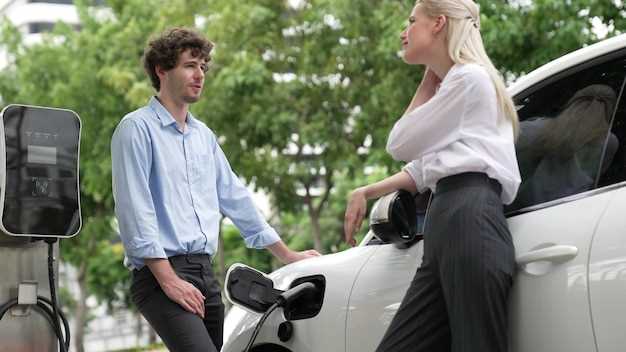Hybrid vs. Plug-In Hybrid – What’s the Difference?

As the automotive industry continues to evolve, the push for environmentally friendly vehicles has led to the rise of hybrid and plug-in hybrid technologies. Both options aim to reduce greenhouse gas emissions and fuel consumption, but they achieve these goals through different mechanisms. Understanding the key differences between hybrid and plug-in hybrid vehicles is essential for making informed choices about sustainable transportation.
Hybrid vehicles utilize a combination of a traditional internal combustion engine and an electric motor, which work together to optimize fuel efficiency. The electric motor assists the gasoline engine during acceleration and captures energy through regenerative braking. This technology allows hybrids to operate primarily on gasoline, but they are designed to enhance fuel economy without the need for external charging.
In contrast, plug-in hybrid vehicles offer a more flexible approach to driving. With larger battery capacities, plug-in hybrids can be charged using a standard electrical outlet or charging station, allowing them to operate in electric-only mode for a certain distance. This capability minimizes reliance on gasoline, particularly for short daily commutes, thereby providing significant potential for reduced emissions. However, it also requires users to be mindful of charging infrastructure and battery range.
Recognizing these distinctions will help consumers choose the right vehicle that aligns with their driving habits and environmental goals. The subsequent sections will delve deeper into the functionalities, advantages, and limitations of both hybrid and plug-in hybrid vehicles, making it easier to navigate the increasingly complex world of eco-friendly transportation options.
Understanding the Basics of Hybrid Vehicles
Hybrid vehicles combine an internal combustion engine with an electric motor to enhance fuel efficiency and reduce emissions. They are designed to optimize performance by leveraging both power sources, allowing for smoother acceleration and reduced reliance on fossil fuels.
There are two primary types of hybrid vehicles: series and parallel hybrids. In series hybrids, the electric motor drives the wheels, while the gasoline engine functions primarily as a generator to recharge the battery. In contrast, parallel hybrids allow both the gasoline engine and electric motor to power the vehicle simultaneously or independently depending on driving conditions.
The energy management system in hybrid vehicles intelligently switches between the engine and motor, maximizing efficiency. Regenerative braking technology captures energy usually lost during braking and converts it into electricity, which is then stored in the battery for future use. This feature significantly contributes to the overall energy efficiency of the vehicle.
Hybrids are equipped with a battery pack that is usually smaller than those used in fully electric vehicles (EVs). This smaller battery allows hybrids to maintain a lighter weight while still providing sufficient electric power for short trips or during low-speed driving, where energy efficiency is critical.
| Hybrid Types | Power Source | Efficiency |
|---|---|---|
| Series Hybrid | Electric motor driven by gasoline engine generator | Optimal for city driving |
| Parallel Hybrid | Simultaneous use of gasoline engine and electric motor | Versatile for various driving conditions |
In summary, hybrid vehicles represent a significant advancement in automotive technology, providing drivers with an efficient and environmentally friendly alternative to traditional gasoline-powered vehicles. By understanding the basic principles behind hybrid technology, consumers can make informed choices about their transportation options.
How Plug-In Hybrids Differ in Battery Capacity
Plug-in hybrid electric vehicles (PHEVs) are distinguished from conventional hybrids primarily by their larger battery capacity, which enables them to operate exclusively on electric power for a certain distance. The battery capacity of a PHEV typically ranges from 8 kWh to 18 kWh, allowing for an electric-only driving range of approximately 20 to 50 miles, depending on the model. This capability significantly reduces gasoline consumption for daily commuting and short trips.
In contrast, traditional hybrid vehicles usually feature smaller batteries, generally around 1 kWh to 2 kWh. These smaller batteries are designed to support the gasoline engine and provide a limited amount of electric power, which is mainly utilized during low-speed driving or to assist the engine during acceleration. This difference in design reflects the core operational intent: PHEVs prioritize electric driving, while conventional hybrids focus on optimizing the efficiency of gasoline engines.
The ability to charge PHEV batteries via an external power source is another critical difference. PHEVs can be connected to home charging stations or standard electrical outlets, allowing for convenient overnight charging. This feature maximizes their electric range, encouraging drivers to use electric modes more frequently. In contrast, traditional hybrids recover their battery energy through regenerative braking and the gasoline engine, resulting in limited electric-only capability.
The variation in battery capacity also impacts vehicle performance. Larger batteries in PHEVs not only provide a longer electric range but also support additional power demands, which can enhance acceleration and performance features. This can make PHEVs more versatile and appealing to drivers seeking a blend of electric efficiency and driving dynamics.
Overall, the battery capacity of plug-in hybrids plays a crucial role in defining their functionality, efficiency, and user experience compared to traditional hybrids. This advantage allows PHEVs to bridge the gap between conventional vehicles and fully electric vehicles, making them an attractive option for environmentally conscious consumers.
Evaluating Fuel Efficiency: Hybrid vs Plug-In Hybrid

When comparing fuel efficiency between hybrid and plug-in hybrid vehicles, it’s essential to understand their operating mechanisms. Traditional hybrids utilize both a gasoline engine and an electric motor. The gasoline engine primarily powers the vehicle and recharges the battery through regenerative braking and engine assistance. This results in improved fuel economy compared to conventional vehicles, with many hybrids achieving an average of 40 to 60 MPG, depending on driving conditions and model efficiency.
In contrast, plug-in hybrids (PHEVs) come with a larger battery that can be charged through an external power source, such as a home charging station. This allows PHEVs to operate on electric power alone for a limited range–typically between 20 to 50 miles–before switching to hybrid mode. Consequently, when driven short distances on electric power, plug-in hybrids can offer exceptional fuel economy, sometimes exceeding 100 MPGe (miles per gallon equivalent) during electric-only operation.
The overall fuel efficiency of a vehicle can depend significantly on driving patterns. For daily commuters who can charge their plug-in hybrid regularly, the potential for reduced fuel consumption is substantial. However, for those who frequently undertake longer trips without access to charging infrastructure, a traditional hybrid may present a more practical solution, as it seamlessly blends both electric and gasoline power without reliance on external charging.
Moreover, factors such as vehicle weight, aerodynamics, and engine efficiency also play crucial roles in determining the fuel efficiency of both types. While hybrids tend to be lighter and often more efficient on the highway, plug-in hybrids excel in urban settings where frequent stops allow for battery recharge through braking. Therefore, evaluating fuel efficiency requires considering individual driving habits and access to charging stations.
Ultimately, whether to choose a traditional hybrid or a plug-in hybrid can depend on specific needs regarding daily travel distance, access to charging, and environmental considerations. Each vehicle type has unique advantages that can lead to varying fuel efficiencies based on usage patterns.
The Impact of Driving Range on Your Choice
When considering the switch to a hybrid or plug-in hybrid vehicle, driving range is a critical factor. Traditional hybrids, utilizing both a gasoline engine and an electric motor, typically offer a combined range that depends heavily on the fuel tank’s capacity and the vehicle’s efficiency. These cars seamlessly transition between electric and gasoline power, allowing for longer trips without the anxiety of running out of charge.
In contrast, plug-in hybrids come equipped with larger battery packs, enabling them to operate on electric power alone for limited distances, usually between 20 to 50 miles. This electric-only range can satisfy short daily commutes effectively. However, once the battery depletes, the vehicle resorts to its gasoline engine, which can affect overall efficiency.
The impact of driving range can influence your choice based on driving habits. If most of your journeys are short, a plug-in hybrid with a suitable electric range might be ideal, as you can minimize gasoline usage. Conversely, if frequent long-distance travel is required, a conventional hybrid may provide greater peace of mind due to its extended fuel range and the absence of charging needs during trips.
Furthermore, charging infrastructure in your area plays an important role in this decision. Plug-in hybrids require access to charging stations to utilize their electric capabilities fully. If these resources are limited, the practical benefits of a plug-in hybrid diminish. Thus, understanding charging availability alongside driving range can help determine the most effective choice for your needs.
Charging Options: What You Need to Know
Understanding the charging options for hybrid and plug-in hybrid vehicles is crucial for potential buyers. These two types of vehicles have distinct charging capabilities that influence their overall efficiency and convenience.
- Hybrid Vehicles:
- Hybrid vehicles primarily rely on gasoline engines combined with electric motors. They do not require external charging.
- The electric battery in hybrids is charged through regenerative braking and the internal combustion engine itself.
- As a result, hybrid vehicles are less dependent on charging infrastructure and can be driven without worrying about finding a charging station.
- Plug-In Hybrid Vehicles:
- Plug-in hybrids can be charged using an external electric power source, such as a home charger or public charging station.
- They feature larger batteries compared to standard hybrids, allowing for longer electric-only driving range.
- Charging options include:
- Level 1 Charging: Utilizing a standard 120V outlet, typically taking several hours for a full charge.
- Level 2 Charging: Using a 240V outlet, which significantly reduces charging time to around 2-4 hours for a full charge.
- DC Fast Charging: Available at some public charging stations, allowing for rapid charging, usually reaching up to 80% in about 30 minutes.
Choosing between a hybrid and a plug-in hybrid will largely depend on your driving habits and access to charging options. For those who drive longer distances or prefer extensive electric-only operation, plug-in hybrids provide more flexibility. Conversely, hybrids offer convenience without the need for charging, making them suitable for a varied range of drivers.
Cost Considerations: Initial Investment and Long-Term Savings
When evaluating the financial implications of hybrid and plug-in hybrid vehicles, it’s essential to consider both the initial purchase price and the potential savings over time. Generally, plug-in hybrids tend to have a higher upfront cost compared to standard hybrids due to their larger battery capacity and advanced technology. This increased expense can be a barrier for some buyers. However, various government incentives and rebates often help offset this initial investment.
In the case of standard hybrids, the initial investment is typically lower, making them more accessible for a wider range of consumers. Nonetheless, hybrids still incorporate advanced technology that can lead to greater fuel efficiency compared to conventional vehicles, offering some cost savings at the pump.
Long-term savings, however, significantly tilt the balance in favor of plug-in hybrids for those who can take full advantage of their electric-only range. By predominantly operating in electric mode, drivers can dramatically reduce their fuel costs. Additionally, many plug-in hybrids qualify for incentives, which can lower total ownership costs. Over time, these vehicles often result in lower maintenance costs due to fewer moving parts in the electric drivetrain, leading to savings on repairs and service.
In contrast, while standard hybrids provide improved fuel economy over traditional gasoline vehicles, their gains may not match the potential savings offered by plug-in hybrids, especially for drivers who have access to charging stations and can maximize electric driving.
Ultimately, the decision between a hybrid and a plug-in hybrid involves weighing immediate financial commitments against potential long-term savings. Understanding individual driving habits and energy costs is crucial for making a well-informed choice that aligns with both financial goals and lifestyle preferences.

